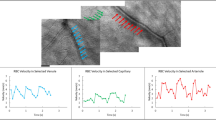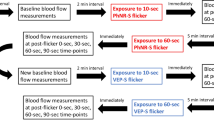Abstract
Purpose: We tested a prototype stimulator interfaced with a commercially available scanning laser ophthalmoscope designed to measure retinal capillary perfusion (Heidelberg Retina Flowmeter (HRF)). The add-on stimulator optically superimposed the image of a monitor display on to the subject's retina coaxially with the imaging optics of the HRF. The purpose of the study was to determine if flicker and pattern stimulation presented in this manner could evoke changes in retinal perfusion that could be measured by the HRF. Methods: The prototype stimulator projected 55° visual angle circular fields of homogeneous flicker, alternating checkerboard, and multi-focal m-sequence hexagonal patterns on the retina of 10 human subjects during acquisition of images by the HRF. Results: Images were successfully acquired and processed. HRF perfusion values during flicker and pattern stimulation were not significantly different from control values. Conclusions: Results of the present study and a previously published study showing a flicker-induced increase in the HRF perfusion values are contradictory. Retinal perfusion measured by the HRF were not affected by flicker and pattern stimulation delivered through the prototype device. These data are not consistent with a large flicker or pattern induced increase in retinal perfusion. The instrumental modification appears promising. However, the raster scan stimulation technique or some other aspect of stimulation or image acquisition may account for the different results in the present study and previous studies in our laboratory and in the laboratories of other investigators.
Similar content being viewed by others
References
Harrison JM, Elliott WR III, Kiel JW, Sponsel WE. Effect of 10 Hz flicker on retinal hemodynamics measured by the Heidelberg retina flowmeter. In: Vision Science and Its Applications, Vol 1, 1997 OSA Technical Digest Series (Optical Society of America, Washington, DC, 1997) 254–7.
Scheiner AJ, Riva CE, Kazahaya K, Petrig BL. Effect of flicker on macular blood flow assessed by the blue field simulation technique. Invest Ophthalmol Vis Sci 1994; 35: 3436–41.
Kiryu J, Asrani S, Mahnaz S, Mori M, Zeimer R. Local response of the primate retinal microcirculation to increased metabolic demand induced by flicker. Invest Ophthalmol Vis Sci 1995; 36: 1240–6.
Riva CE, Harino S, Shonat RD, Petrig BL. Flicker evoked increase in optic nerve head blood flow in anesthetized cats. Neurosc Lett 1991; 128: 291–6.
Riva CE, Cranstoun SD, Mann RM, Barnes GE. Local choroidal blood flow in the cat by laser doppler flowmetry. Invest Ophthalmol Vis Sci 1994; 35: 608–18.
Zinser G. Scanning laser Doppler flowmetry: principle and technique. In: Pillunat LE, Harris A, Anderson DR Greve EL, eds. Current concepts on ocular blood flow in glaucoma. The Hague, the Netherlands: Kugler Publications 1999; 197–204.
Michelson G, Schmauss B, Langhans MJ, Harazny J, Groh MJ. Principle, validity, and reliability of scanning laser Doppler flowmetry. J Glaucoma1988; 5: 99–105.
American National Standard for the Safe Use of Lasers, ANSI Z136.1-1986.
Seeliger MW, Narfström J, Reinhard E, Zrenner, Sutter E. Continuous monitoring of the stimulated area in multifocal ERG. Doc Ophthalmol 2000; 100: 167–84.
Kagemann L, Harris A, Chung H, Jonescu-Cuypers C, Zarfati D, Martin B. Photodetector sensitivity level and Heidelberg retina flowmeter measurements in humans. Invest Ophthalmol Vis Sci 2001; 42: 354–7.
Burns SA, Elsner AE, Kreitz MR. Analysis of nonlinearities in the flicker ERG Optom Vis Sci 1992; 69: 95–105.
Berman SM, Greenhouse DS, Bailey IL, Clear RD, Raasch TW. Human electroretinogram responses to video displays, fluorescent lighting, and other high frequency sources. Photometry Vis Sci 1991; 68: 645–62.
Vo Van Toi, Riva CE. Variations of blood flow at optic nerve head induced by sinusoidal flicker stimulation in cats [published erratum appears in J Physiol (Lond) 1995; 484: 811]. J Physiol1995; 482: 189–202.
Petrig BL, Riva CE, Hayreh S. Laser Doppler flowmetry and optic nerve head blood flow. Am J Ophthalmol 1999; 127(4): 413–25.
Riva CE, Falsini B, Logean E. Flicker-evoked responses of human optic nerve head blood flow: Luminance versus chromatic modulation. Invest Ophthalmol Vis Sci 2001; 42: 756–62.
Mendel MJ, Riva CE, Petrig BL, Cranstoun SD. Diffuse luminance flicker induces an increase in optic nerve head blood flow in humans. In: Vision Science and Its Applications, Vol 1, 1994 OSA Technical Digest Series (Optical Society of America, Washington, DC, 1994) 242–5
Tsang AC, Harris A, Kagemann L, Chung HS, Snook BM, Garzoi HJ. Brightness alters Heidelberg Retinal Flowmeter measurements in an in vitro model. Invest Ophthalmol Vis Sci 1999; 40: 795–9.
Chung HS, Harris A, Roff EJ, Kageman L, Evans DW, Halter PJ. Superior and inferior peripapillary retinal vessels responds differently to changing blood level of oxygen and carbon dioxide and metabolic demand. Invest Opththalmol Vis Sci 1998; 39: S263.
Ieraci C, Lovasik JV. Correlating nerve fiber layer thickness with blood flow in the human eye. Invest Opththalmol Vis Sci 1997; 38: S1049.
Kiel JW, Elliot WR, Harrison JM. Preliminary evaluation of the Heidelberg flowmeter. In: Proceedings of the 5th International Meeting on Scanning Laser Ophthalmoscopy, Tomography, and Microscopy. San Antonio, Texas, October, 1995. Abstract.
Bonner RF, Nossal R. Model for laser Doppler measurement of of blood flow in tissue. Appl Opt 1981; 20: 2097–107.
Chauhan BC, Smith FM. Confocal scanning laser Doppler flowmetry: experiments in a model flow system. J Glaucoma. 1997; 6: 237–45.
Author information
Authors and Affiliations
Rights and permissions
About this article
Cite this article
Schmeisser, E.T., Harrison, J.M., Sutter, E.E. et al. Modification of the Heidelberg retinal flowmeter to record pattern and flicker induced blood flow changes. Doc Ophthalmol 106, 257–263 (2003). https://doi.org/10.1023/A:1022973315359
Issue Date:
DOI: https://doi.org/10.1023/A:1022973315359




